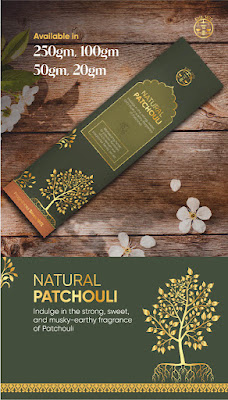Monsoon Incense is
the new name for Good Incense, the brand that Eugene of Ukraine runs alongside
Bhagwan incense. This Patchouli was sent to me by Eugene for review a year or two ago, about a year after he had sent me samples of
Damodardas Bhagwandas Sugandhi of Pune (DBS) incense, such as the
Agarwood and the
Natural Patchouli. Eugene had spent some months in India researching for his incense business, and we had talked together a lot, as he was gathering information and ideas where to look.
Pune seemed a good place to go, as that is the home of
Haridas Madhavdas Sugandhi (HMS), who supply many Western (and domestic) traders, such as
Harry Hari and
Temple of Incense. While there, Eugene got samples from
Vinasons and DBS, and sent them to me. I raved about DBS - who were unknown in the West at the time, and I raved about another of Eugene's discoveries,
B.G Pooja Nag Champa. Not long after that, Everest Trader reached out to those shops and started selling their incense. While I am pleased that the incense from these outlets is now better known in the West, and under their own names, I do feel uncomfortable that, albeit inadvertently, some of Eugene's work had been somewhat taken over by another trader because of me. However, this appears to be somewhat common in the incense world, and Eugene and I have spoken about it, and are cool about it. I did not at any point betray a confidence.
I had the DBS Natural Patchouli and the Good Incense Patchouli (as it was called then) together in my drawer for a while, and uncovered them a couple of days ago. The Good / Monsoon Incense Patchouli struck me as very similar to the DBS Patchouli, though sharper, brighter, fresher, and quite minty compared to the DBS which is more musky and earthy. I assumed I put them together as I wanted to compare them. So I asked Eugene if they were both by DBS, and if the difference between them could be put down to batch variation, or if it was that the Good/Monsoon version was fresher. He replied that they are both from DBS, but that he had asked DBS to put in 10% more oil to make it fresher. He also said that he would be OK with me saying that the Monsoon Patchouli is made by DBS.
At that point, though there is a difference, I had no particular preference. Both are enjoyable on their own terms. I like the musky, dusty, powdery, more outdoorsy, natural feel of the DBS, but I also like the brightness and sweetness and freshness of the Monsoon. Overtime, I find that the vanilla notes of the Monsoon tend to become a little cloying, while the more earthy qualities of the DBS remain intriguing, almost compelling. But it's a minor difference, because the Monsoon compensates by being more youthful and uplifting.
On the burn there is perhaps less difference to note, except perhaps in strength and depth and diffusion. The Monsoon Incense feels bolder, which is more my thing. Bolder, sharper, more defined, and longer lasting. Distinctly patchouli, but sweetened by the vanillin crystals, which appear to be a feature of the "school of Pune" incense. Vanillin crystals are sometimes used in the same way as
halmaddi to "fix" the perfume notes so they are clearer and last longer. And this appears to be a tradition in Pune.
Overall I end up liking the Monsoon Patchouli slightly more than the DBS Natural Patchouli. I like the boldness and freshness and the sheer joy. And I find the vanillin uplifts the patchouli in a delightful manner. As a big patchouli lover, I end up loving this a lot. I'm perhaps a bit muddled by the vanillin, and would perhaps prefer it without the vanillin, but I suspect that its the vanillin that is really boosting and lifting the patchouli. At the moment this is the biggest, freshest, greenest, most joyful patchouli incense I've burned (apart from the legendary and mysterious
Aargee Imperial Maharaja Patchouli - but that is out of print, and nobody knows who made it). Nice one.
Date: April 2025 Score: 42
***























.jpg)
















